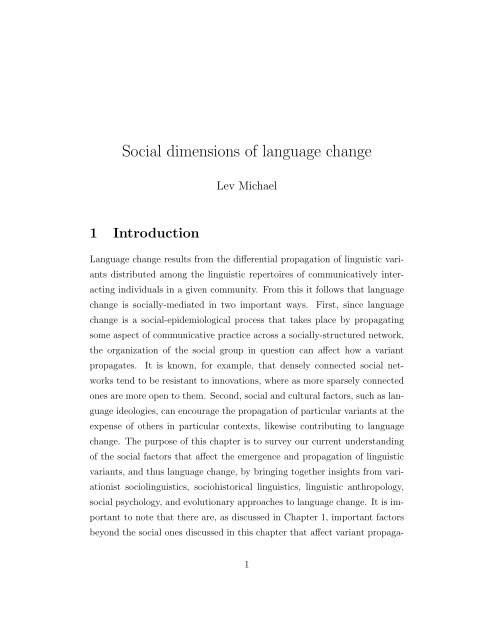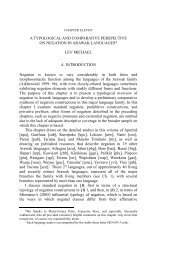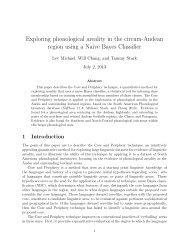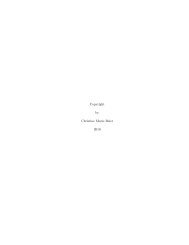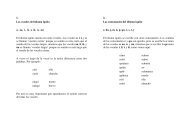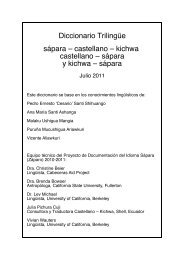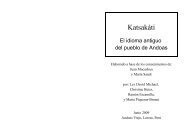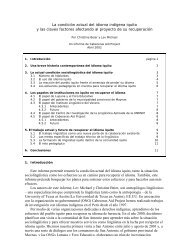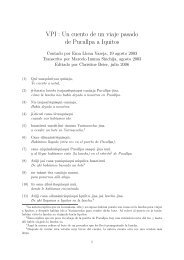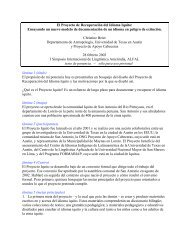draft manuscript - cabeceras.org
draft manuscript - cabeceras.org
draft manuscript - cabeceras.org
Create successful ePaper yourself
Turn your PDF publications into a flip-book with our unique Google optimized e-Paper software.
Social dimensions of language changeLev Michael1 IntroductionLanguage change results from the differential propagation of linguistic variantsdistributed among the linguistic repertoires of communicatively interactingindividuals in a given community. From this it follows that languagechange is socially-mediated in two important ways. First, since languagechange is a social-epidemiological process that takes place by propagatingsome aspect of communicative practice across a socially-structured network,the <strong>org</strong>anization of the social group in question can affect how a variantpropagates. It is known, for example, that densely connected social networkstend to be resistant to innovations, where as more sparsely connectedones are more open to them. Second, social and cultural factors, such as languageideologies, can encourage the propagation of particular variants at theexpense of others in particular contexts, likewise contributing to languagechange. The purpose of this chapter is to survey our current understandingof the social factors that affect the emergence and propagation of linguisticvariants, and thus language change, by bringing together insights from variationistsociolinguistics, sociohistorical linguistics, linguistic anthropology,social psychology, and evolutionary approaches to language change. It is importantto note that there are, as discussed in Chapter 1, important factorsbeyond the social ones discussed in this chapter that affect variant propaga-1
tion and language change, including factors related to linguistic productionand perception, and cognitive factors attributable to the human languagefaculty (see Chapter 1).1.1 Theorizing variation and language changeAs Weinreich, Labov, and Herzog (1968) originally observed, theories of languagethat assume linguistic variation to be noise or meaningless divergencefrom some ideal synchronically homogeneous linguistic state – to be eliminatedby ‘averaging’ or ‘abstraction’ – encounter profound difficulties inaccounting for language change. In response to structuralist and generativetheories that make problematic assumptions of this sort, Weinreichet al. argued that languages are not essentially homogeneous entities thatare encumbered by an uninteresting overlay of random variation, but arerather dynamically <strong>org</strong>anized by an ‘orderly heterogeneity’, in which variantsare distributed throughout a speech community in socially-patternedways ( e.g. with respect to age and socio-economic class). Language change,they argued, emerges from this orderly heterogeneity as increasing numbersof individuals in a speech community employ a particular competing variantwithin this <strong>org</strong>anized linguistic heterogeneity, and after a period in whichtwo or more variants are in use, cease using the former variant.In recent years, further theorization of this basic picture has taken up byevolutionary approaches to language change (e.g. Croft 2000, Keller 1994,Mufwene 2001, Ritt 2004), based on generalized accounts of evolutionaryprocesses that abstract from the particulars of biological evolution so thatprocesses of cultural change, including linguistic change, can be analyzed inevolutionary terms (Hull 1988: 408-409, Hull et al. 2001, Price 1995). Theseapproaches see language change as arising from the differential replicationof linguistic variants, where variants are best understood as the socially-2
situated communicative competence (Hymes 1972) related to use of a particularlinguistic element (but compare, for example, Croft (2000) and Ritt(2004) for differences regarding the characterization of the entities replicatedin linguistic evolution). Such competence combines knowledge of the structuralcharacteristics of a linguistic element with its social-indexical properties(Thomas 2011), be elements phonetic (e.g. Foulkes and Docherty 2006) ormorphosyntactic (e.g. Plug 2010) in nature. 1Evolutionary approaches to language change consider the replication oflinguistic competences to be critically mediated by their actual use to producethe linguistic elements they generate (or their use to interpret the elementsproduced by others). Significantly, competence use is implicated in two quitedifferent type of replication. In the first type of replication, their use forestallsthe decay of competences in the speakers themselves (see, e.g. Ecke (2004),Schmid and Dusseldorp (2010), and Badstübner (2011) on the loss of L1competence), resulting in replication of the speakers’ own competence. Inthe second type of replication, the competence is acquired by a new speakeras a result of being exposed to it, such that the competence is now foundboth in the original host and a new host. 2The differential propagation ofa variant, leading to language change ultimately depends on both types ofreplication.The replication of a given competence through its acquisition by newspeakers thus requires exposure to its use, so that cross-speaker replicationdepends on the potential acquirers’ positions in the social network relative tothose who already possess it, and on access to the social contexts in which it is1 Cross-linguistic work in language socialization theory supports this characterizationof competence, showing that children simultaneously acquire grammatical knowledge andknowledge of its socially appropriate and effective use (Ochs 1979, Ochs and Schieffelin1984, 2012, Schieffelin and Ochs 1986, 1987).2 Note that outside of contexts of initial acquisition (e.g. by children) the newly acquiredvariant will typically co-exist with the older variant, at least initially.3
used. Cross-speaker replication is also affected by the social-indexical propertiesof the linguistic elements generated by the competence, since theseproperties play a crucial role in the frequency with, and circumstances inwhich, they are used, as mediated by the perceived social efficacy of the elementin question. Language change emerges, then, as the result of individualchoices (at varying degrees of consciousness) of variants, motivated by individualinteractional goals that, by invisible hand processes, lead to largescale changes in the distribution of variants in a speech community (Keller1994: 90-107).The final general factor to consider, implicated in the efficacy of connectionsin social networks as transmitters of variants, is age and its effects onhow likely a speaker is to acquire a given competence. Age, in this respect, isperhaps not a ‘social’ phenomenon as such, but nevertheless has an indirectsocial effect in introducing acquisition asymmetries into social networks.2 Social and cultural factors in the selectionof variantsOn the view sketched in the preceding section, language change arises fromthe differential propagation of linguistic variants in a population, a processthat ultimately reduces to a process of individual speaker selection of variantsin particular communicative events. The full set of factors affecting selectionof course extend far beyond social ones, but the very existence of ‘orderlyheterogeneity’ indicates that social factors play a significant role in selection.Efforts to theorize the role of social factors in selection have produced twogeneral types of accounts: 1) accounts based on the social valuation 3 of vari-3 i.e ideological or cultural valuation. ‘Ideology’ is understood in a variety of ways inhumanistic and social scientific disciplines (Woolard 1998), but to the degree that ‘culture’and ‘ideology’ can be usefully distinguished, the former is understood to be comparatively4
ants; and 2) accounts based on relatively unconscious processes of linguisticaccommodation to interlocutors in interaction.2.1 Variant selection and ideological valuationAccounts of variant selection based on the social valuation of variants haverelied on a number of different conceptualizations of valuation, including‘prestige’, ‘covert prestige’, ‘group identity’, and ‘individual identity’. Suchexplanations attribute selection of a particular variant to a speaker’s desireto lay claim to a particular social status, group membership, or individualtrait, by virtue of employing a variant with particular prestige or identityqualities. In Labov’s (1966) classic study of the use of [r] ∼ [∅] variants of/r/ by New York speakers of English, for example, speakers’ preferential useof the [r] variant in particular interactional settings was attributed to theprestige associated with this variant. In his study of variation on Martha’sVineyard, in contrast, he attributed the use of [@w] and [@j] variants of /aw/and /aj/, respectively, to speakers’ identification with the island and positiveevaluation of island life, in comparison to the off-island world (Labov 1972: 1-42). And in her discussion of the stylistic use of hypercorrect forms by acommunity of self-identified Californian adolescent nerds, Bucholtz (2001)does not argue that these elements are prestigious or associated with somerecognizable regional identity as such, but rather that these variants index aparticular ‘uncool’ social stance in opposition to common youth culture.It has become increasingly clear that these different ways of conceptualizingmotives for variant selection can be theorized more coherently byrecourse to the notions of indexicality and language ideology (Eckert 2008,shared or presupposed by members of a social group, while the latter is comparativelysocially-positioned and contested. Practice theory makes a similar distinction between therelatively presupposed and shared doxa and the meta-discursively available and contestedorthodoxy and heterodoxy (Bourdieu 1977).5
Johnstone and Kiesling 2008). It is useful to introduce the concept of indexicalorder, which distinguishes first order indexicals from higher order(‘n+1’) ones. With respect to the sociolinguistic phenomena of interest, saythe [∅] rhotic variant, the first order indexical function of a variant simply‘points’ to the user of the variant having the competence to use that variant,while the second order indexical function associated with that variantindexes the membership of that individual in a recognizable social categoryby virtue of salient ideologies. Yet higher-order indexical functions manifestsas a variant’s indexing of socially salient attributes that can be predicatedof individuals (Silverstein 1976, 2003), which arise through the interaction ofsecond order indexicality and ideologies regarding those groups, which predicateof them particular social attributes. Returning to non-rhoticity in NewYork, for example, Bonfiglio (2002) presents a historically-informed accountthat relates non-rhoticity to early 20th century xenophobic ideologies (as discussedin L. Milroy (2004)), which can be usefully recast in terms of theseindexical orders. Briefly, non-rhoticity was an second order index of majoreast coast metropolitan populations, while rhoticity was an index of populationsfurther west. At the same time, the immigrant populations of thesecities, and by extension, the populations of these cities as a whole, came tobe understood in the prevalent racist ideology of the era as miscegenatedand degenerate, in contrast to the pure American population of the rhoticheartland. By means of this ideological mediation, rhoticity became a higherorder index of racial purity and an idealized America, with the concomittantdevaluation of non-rhotic varieties.From this perspective, the notions of ‘prestige’ and its somewhat problematiccounterpart ‘covert prestige’ are understood as deriving from theindexical properties of variants. In the case of /r/ variants in the New Yorkspeech community, for example, [r] and [∅] may index membership in upperand lower social classes, respectively; and via ideological identifications of6
membership in these classes with particular social and individual dispositions,index personal traits of, say, relative sophistication, intelligence, andthe like. ‘Covert prestige’ can likewise be understood as arising from a variant’ssecond order indexation of a socio-economically subordinate group andthe higher-order indexation of socially evaluated traits associated with thatgroup. The explanation, for example, of men’s selection of phonological variantsassociated with lower classes in Norwich English (Trudgill 1972) liesnot in the so-called ‘covert prestige’ of these variants, but rather in theirhigher-order indexation of masculinity, on the basis of ideologies linking genderidentities and class (Gal 1995: 172-173). ‘Prestige’ and ‘covert prestige’are thus forms of higher-order indexicality that are readily recognizable interms of local hierarchies of social valuation, mediated, in most cases, by thehierarchical social relations among the groups for which the variants functionas second-order indices.The indexicality-based account of social valuation is also applicable to‘stylistic’ selection of variants, such as the use of hypercorrect forms by adolescentCalifornian nerds, mentioned above. Such stylistic uses of variantstrade principally on higher-order indexical properties of elements such as‘intelligence’ or ‘formality’, whose lower-order indexical roots may be quiteobscure at this point.Although the indices discussed so far have been phonological in nature,it is important to note that lexical and grammatical indices are commonalso. As an example of the latter, consider Kun-dangwok, a set of patriclanlects found among the Bininj Kun-Wok of Arnhemland. The Kun-dangwokare distinguished by suffixes or interjections unique to each patriclan, whichfunction as pure indexicals (i.e. carry no semantico-referential meaning), indicatingmembership in the associated patriclan. The Djordi clan Kun-dangwokprefix njarra-, exemplified in (2.1), adds no referential meaning to the utterance,but indicates that the speaker is a member of the Djordi clan.7
(1) Yi-kinje-men!2sg-cook-imp‘You cook it!’(2) Yi-njarra-kinjemen2sg-Djordi.clan.prefix-kinjemen‘You njarra cook it!’ (adapated from Garde (2008: 150))Social-indexical properties have also been argued to have been crucial inthe loss of the English T/V contrast, formerly instantiated in the contrastbetween thou and you (in the singular). According to Silverstein (1985), theloss of thou occurred in three stages. In the first stage, English Puritan sects,and Quakers in particular, interpreted use of you as indexical of asymmetricsocial relations, to which they were strongly opposed. In reaction, theyadopted thou/thee as their preferred form of second person address, amongother things indexing their commitment to social equality. In the secondstage, the use of thou came to be indexical of Quaker-hood itself, renderingit problematic for non-Quakers to use, since Quakers were generally held inlow esteem. In the third stage, non-Quakers abandoned the use of thou inorder to avoid indexing Quaker-hood, leading to such extensive de-selectionof the form that it ceased to form part of the repertoire of most Englishspeakers.2.2 Cultural factors in the selection of variantsAlthough variationist sociolinguistics has tended to focus on selectional pressureslying towards the ideological end of the culture-ideology spectrum,ethnographically- and typologically-influenced work has also argued for therole of cultural norms in language change, such as lexical avoidance behaviorsand culture-driven grammaticalization.8
Llexical avoidance behaviors (sometimes called ‘language taboos’), involvethe deliberate avoidance of specific lexical items, based on culturalbeliefs about the inappropriateness or harmfulness of their use (Allan andBurridge 2006; Fleming and Lempert 2011, Frayzingier and Jirsa 2006). Postmortemname avoidance is a geographically widespread form of lexical avoidance,where forms identical to or similar to the name of a recently deceasedindividual are avoided. Frazer (1922) provides an early discussion of thisphenomenon in numerous cultures, and more recent discussions tie this practiceexplicitly to language change. Fleck and Voss (2006), for example, arguethat the profusion of synonyms for game animals in the Mayoruna languages(Panoan) of western Amazonia has its origin in postmortem name avoidance,while Elmendorf (1959) cites this practice as the reason for the eliminationof particular lexical items among Coast Salishan groups. Simons (1982),in a wide-ranging discussion of the effects of lexical avoidance behavior onthe lexicons of Austronesian languages, likewise mentions postmortem nameavoidance, but also discusses avoidance behavior linked to the names of chiefsand individuals in certain kinship categories (see Tuite and Schulze (1998)for a similar phenomenon in Caucasian languages). Simons proposed that anumber of strategies were employed in avoidance practices, including phonologicalmodification of lexical items, borrowing from neighboring languages orvarieties, and lexical innovation. Another avoidance practice, animal nameavoidance, has been documented for species of particular spiritual significanceamong Indo-European (Emeneau 1948, Smal-Stocki 1950), Australian(Frazer 1911: 418), and Californian (Bright 2004) societies, among others,resulting in their replacement with innovated forms.It is worth noting that in some cases, there is controversy surroundingthe long-term consequences of lexical avoidance behaviors on language behavior.Dixon (2002), for example, claims that lexical avoidance behaviorin Australian languages (among other things) is responsible for such mas-9
sive borrowing among Australian languages that the Comparative Methodcannot be usefully applied to them. However, Alpher and Nash (1999) andBowern et al. (2011) argue that borrowing rates are in fact not, in general,particularly high in Australian languages, casting doubt on the importanceof lexical avoidance in understanding change in these languages.Allan and Burridge (2006) argue that lexical avoidance behaviors oftenresult in a recursive process by which euphemistic replacements for avoidedforms come to be stigmatized themselves, sometimes resulting in the vastaccumulation of dysphemic synonyms in semantic domains in which lexicalavoidance is prevalent. Allan and Burridge (2006: 242-243) report on sucha case in English, finding that the language has “accumulated more than1,000 expressions for ‘penis’, 1,200 for ‘vulva/vagina’, 800 for ‘copulation’and . . . 2,000 expressions for ‘wanton woman’.”Cultural factors have also been argued to promote morphological and syntacticchange, through indirect processes in which social norms or practicesincrease the discourse frequency of particular words or structures, therebycontributing to their grammaticalization (Simpson 2002). Culture-drivengrammaticalization may involve fairly broad cultural norms, such as thoseprioritizing indirectness and the avoidance of face threatening acts (Wheeler2009), which may lead to the conventionalization and grammaticalizationof expressions indicating smallness, approximation, and demurral, in facethreateningconstructions like those involved in requests or directives (Beeching2005, 2007). Similarly, cultural preferences for communicative indirectnessin personal reference may drive processes like preferences for pronounreplacement in illocutionarily-loaded constructions (e.g. those involving deonticor assertoric force), and the development of vacuous hearsay constructions(Frayzingier and Jirsa 2006).Culture-driven grammaticalization has also been argued to be responsiblefor the development of ‘kintax’ systems (which indicate kinship relationships10
y grammatical means) in some Australian languages, due to the central roleof kinship relations in ritual life of the societies in which these languages arespoken (Evans 2003), and the grammaticalization of quotative evidentials inNanti. Michael (to appear) argues that Nanti cultural norms regarding respectfulbehavior towards others militate against direct reference to others’mental states, leading to the extensive use of speech report verbs to quoteutterances that (indirectly) index mental states instead. The resulting highfrequency of these verbs contributes, on this account, to their grammaticalizationinto quotative evidential particles.2.3 Interaction and accommodationWhereas the accounts in the previous section explain variant selection (andits relation to language change) in terms of ideas or practices attributableto social groups of various sizes, the accomodation-theoretic approaches discussedin this section instead rely on psychological tendencies inhering inindividuals. The most prominent of these approaches, Communication AccommodationTheory (CAT), argues that interlocutors tend to converge linguisticallyover the course of an interaction (Giles 1973), due to “a speaker’sor a group’s need (often unconscious) for social integration or identificationwith another” (Giles et al 1991). Conversely, interlocutors may diverge (justas unconsciously), if they are antagonistic or socially disaligned with oneother (Bourhis and Giles 1977, Bourhis et al. 1979). Although CAT as suchsprang from social social psychology, similar explanations for the social basisof language change can be found in linguistics, as in the work of HermannPaul (Weinreich et al. 1968: 107-108), Bloomfield (1933: 476), and in certainrespects, Labov (2001: 19-20). More recently, Trudgill (1986, 2004), hasdeveloped an influential account of dialect-contact driven language changethat couples accommodation to social network-based reasoning regarding fre-11
quency (see §3).One of the chief attractions of accommodation-based accounts of variantselection for sociolinguists like Trudgill (2008) is that they avoid recourseto notions like ‘identity’, which may be desirable in cases in which it is notclear that any such ideological construct was relevant to linguistic change inquestion. Since, according to Trudgill (2008: 252) “linguistic accommodationis not driven by social factors such as identity at all but is an automaticconsequence of interaction,” accomodation seems to be a powerful alternativeto indexical-ideological selection mechanisms.However, while proponents of CAT-based theories of language changelike Pickering and Garrod (2004) and Trudgill (2008), correctly consider accommodationprocesses to be automatic and unconscious processes, theirconclusion that accommodation processes are uninfluenced by social considerationslike those that inform ideological-indexical selection is somewhat atodds with work in CAT by social psychologists. Apart from the fact thatwork in CAT has found that speakers converge or diverge with interlocutorspartly on the basis of whether they identify with their interlocutors or not(see also Shepard et al. 2001), Auer and Hinskins (2005: 342-343) note thatspeakers tend to converge not to actual interlocutors, but to stereotypes ofsocial categories in which they place their interlocutors, an ideological processpar excellence.Recent experimental work confirms that while convergence is automaticand unconscious, it is nevertheless sensitive to social categories in a varietyof complex ways. Pardo (2006, 2010), for example, found that in experimentalinstruction-giving and -receiving tasks, female givers converged to femalereceivers, but in contrast, that male receivers converged to male givers. Genderof interlocutors and the social roles they occupy in an interaction thusappear to be important considerations for the direction that speakers accommodate.Babel (2012) similarly found that speakers’ accommodation to12
ecorded speech depended significantly on images of the speakers to whichthe recording was attributed, finding significant differences based on gender,race, and perceived attractiveness. In other experimental work, Dimov etal. (2012) found that individuals who rate low on social-psychological empowermentmeasures were more likely to compensate for auditory feedback,suggesting that a speaker’s inclination to accommodate may be in part afunction of their social position. Dimov et al. (2012) commented that “[if]traditionally powerless segments of the society . . . are systematically inclinedto alter their speech when exposed to novel phonetic variants, then they maybe the locus of sound change actuation.”The picture that emerges from this body of work allows that processesof accommodation operate differently from indexical-ideological ones (e.g. inbeing more unconscious and automatic), but that accommodation processesare nevertheless sensitive to interactional roles and social categories. Thiswork is consonant with research that shows, for example, that perception ofspeech sounds is affected by speakers’ perceived social characteristics suchas gender, age, and regional identity (e.g. Drager 2010, Hay, Warren, andDrager 2006). In short, it is far from clear that selection by accommodationis insensitive to social categories, roles, and positions; it rather appears tobe a process that is informed in different ways than indexical-ideologicalprocesses by the social milieu in which it takes place.2.4 Competing explanations for selectionThe indexical-ideological and accommodation-network accounts of variant selectiondiscussed above present two quite different explanations for why variantsmay be selected. Labov (2001: 20) suggests that indexical-ideologicaleffects are, in general, quite weak, and that language change can be largelyexplained in terms of accommodation and frequency effects stemming from13
an individual’s social network position. Trudgill (2004) elaborates this stanceinto a ‘deterministic’ theory of new dialect formation in tabula rasa situations(e.g. during the settling of New Zealand), which relies solely on frequenciesof interaction among speakers of different dialects in the dialect contact situation,observing that he does not “find it at all necessary . . . to call on thesocial factor of ‘prestige’ or related factors such as ‘status’ or ‘stigma’ as explanatoryfactors” (p. 149). Trudgill (2008: 251) even goes so far as to turnthe common assumption about the role of identity in variant selection on itshead, arguing that varieties only become emblems of identity subsequent tothe processes of accommodation that lead to the formation of new varieties.Evaluate the relative contributions of indexical-ideological and accommodationnetworkprocesses to language change (and of course perceptual and productionfactors no doubt also play an important role) is not an easy, however.Wolfram and Schilling-Estes (1996, 2003), for example, argue that althoughdeterministic accounts of dialect contact like the gravity model (see below)have explanatory value, there appear to be cases where recourse must bemake to indexical-ideological explanations. They observe, that is essential toknow that the pronunciation of /ay/ as [Oy] in Ocracoke English is a markerof Ocracoke island identity in order to understand why this pronunciationhas resisted the incursion of non-Southern [a I ].In recent years, exploration of deterministic theories have been aided byrecourse to computational models, which have sought to evaluate whetheraccommodation effects in a network of communicatively-interacting individualscan by themselves produce language change outcomes resembling thoseobserved in the real world. Both Baxter et al. (2009) and Fagyal et al. (2010),for example, developed evolutionary models of language change (§1.1) thatexplicitly modeled variant selection through time among groups of interactingindividuals in social networks. Fagyal et al. (2010) found that variantdistributions in networks from which asymmetric influence has been excluded14
failed to converge to a single dominant variant (i.e. failed to exhibit languagechange) and that convergence only occurred when asymmetric influence wasintroduced into the network, and more specifically, when relatively highlyinfluential individuals were also hubs in the social network. This result notonly suggests that social factors are relevant, but that social factors andnetwork structure in fact interact in determining language change.Baxter et al. (2009) is an explicit evaluation of Trudgill’s (2004) deterministicmodel of New Zealand English formation and focuses on determiningthe time that would be necessary for convergence to a new dialect to takeplace, assuming that only frequency of exposure due to position within thesocial network is relevant, and not factors like differential influence of individualswithin the network. They likewise reject this model, on the basisthat convergence time exceeds the actual time in which New Zealand Englishactually developed. These results suggest that social factors may be intrinsicto language change, and purely accommodation-network theories may beinadequate.Complementary results emerge from historical sociolingustic work by Nevalainenand Raumolin-Brumberg (1996: 55), who find that indexical-ideological (‘social’)factors are significant in the early rising portion of the sigmoid curve(see §3, below) and somewhat less so in the main rising portion of the sigmoidcurve, but relatively insignificant in the incipient stage and in the phasewhere the change approaches completion. This work suggests that accommodationand indexical-ideological factors both affect variant selection, butto different degrees at different stages of spread of a variant within a speechcommunity. Note that this result is consistent with Labov’s (2001: 320) generalizationregarding ‘change from below’, discussed below, that such changetends to begin as a relatively unconscious process, but can then come to bean object of explicit social evaluation.15
3 Dynamics of differential propagationIndividual variant selection leads to language change when it forms part oflarger-scale processes of differential variant propagation within the speechcommunity. In this section I summarize the contribution of variationist sociolinguisticsto understanding these larger scale processes, focusing on researchthat clarifies the social position of early adopters and leaders of change, andon how social <strong>org</strong>anization plays a role in facilitating or inhibiting propagation.I first discuss work that adopts a relatively coarse-grained model of thesocial world as constituted of groups like ‘classes’ and ‘genders’ (see Rickford1986 for an early critique of the unreflective use of such categories), andthen turn to the more fine-grained social models found in network theoryapproaches.Any account of the differential propagation of variants in a given speechcommunity depends on an understanding of how repertoires of linguistic competencesare formed (see Sanford (this volume) for a detailed discussion oflanguage acquisition). A useful starting point in this discussion is to distinguishprocesses of repertoire formation in terms of the two major typesof language change in which they are involved: ‘change from below’ and‘change from above’. The former type of acquisition consists of ‘natural’,community-internal types of change, while the latter consists of acquisitionfrom ‘external’ sources, especially due to language/dialect contact, the influenceof learned registers, or changes in the social evaluation of linguisticforms.Natural change from below is typically divided three major phases: 1)transmission, which consists of normal child language acquisition, by whichchildren acquire their role models’ linguistic competences; 2) incrementation,through which older children and adolescents advance change (i.e. increasingthe frequency of particular variants), beyond that of their role models’16
competences (Labov 2007); and 3) stabilization, which involves the relativeconsolidation of the repertoire, where, as Labov (2001: 418) observes, fullsociolinguistic competence may not be achieved until late adolescence. Itshould be emphasized that transmission includes the acquisition of variation(Kerswill 1996, Labov 2001: 417-418) and associated social-indexical features(see §1.1), and that the sources for transmission are not necessarily onlycaretakers, but may also include other members of the speech community,including other adults and peers (Kerswill and Trudgill 2005). As a result,the repertoires that children acquire during transmission are shaped by thepatterns of variant selection among a potentially broad set of linguistic rolemodels.The other major process in repertoire formation involves acquisition ofcompetences later in life. As Kerswill (1996) observed, while certain competencesare acquired in childhood or early adolescence as part of transmission,such as those associated with phonological oppositions and ‘grammaticalparameters’, other competences can be acquired over the lifespanof an individual, including lexically diffused phonological changes (see also,e.g. Sankoff and Blondeau 2007, Harrington et al. 2000), ‘Neogrammarianchanges’, mergers, and reassignment of words to new morphosyntactic classes(see e.g. Tagliamonte and D’Arcy). These latter types of acquisition are centrallyinvolved in the ‘diffusion’ of competences in adult repertoire change,the most significant type of ‘change from above’.The substantial body of work on linguistic change from below has yieldeda number of empirical generalizations regarding the social location of leadersof change in such processes, chief among them the ‘curvilinear principle’(Labov 2001: 31-33, 460) and the role of women in leading change (Labov2001: 188). The curvilinear principle identifies the central sections of thesocioeconomic hierarchy (for Labov, the ‘upper working class’) as the socialposition of leaders of sound changes in progress, and in situations in which17
there is gender-based differentiation, it is women who typically lead changesfrom below. As Labov (2001: 447) and Tagliamonte and D’Arcy (2007)observe, while both boys and girls acquire the phonological systems of theirlinguistic role models, older girls and adolescent women tend to incrementat considerably higher rates than their male counterparts, with the resultthat women tend to lead linguistic change. The curvilinear principle and therole of women interact in a subtle manner, which Labov (2001: 320) arguesis dependent on speakers’ consciousness regarding the change in progress.Briefly, in the early stages of a change (from below), sex and social class arerelatively independent of one another, and the pattern of change exhibitsthe class-based curvilinear pattern. As awareness of the relevant variationincreases however, and variants come to be indexically imbued, the role ofgender becomes significant, with women typically leading men.In the case of both ‘curvilinear change’ and women-led change, the majormechanism driving the change is understood to be incrementation, which inthe latter case, is coupled with intergenerational transmission in differentialpropagation of variants in the speech community. Although the frequencyof incremented changes tends to drop during stabilization, women’s use ofthe relevant innovative variant tends to remain comparatively high, with thishigher frequency tending to be acquired by their children through transmission.As Tagliamonte and D’Arcy (2007) and (Labov 2001: 457) demonstrate,a model that couples a treatment of incrementation by females as a logisticfunction of time (rather than a linear function) with transmission of the stabilizedincrement to their offspring, accounts for both observed gender-basedvariation in apparent time and the generational pattern by which womenlead men.A complementary understanding of leaders of linguistic change emergeswhen society is conceived not in terms of class strata, but as a network ofsocial relations, which are commonly represented schematically as graphs,18
with individuals as nodes in the graph (see e.g. L. Milroy 2008: 551). Fromthis perspective, the distinction that emerges as important is not large-scalegroupings such as class, but rather whether individuals are nodes in highlydense and multiplex networks (i.e. are involved in ‘dense ties’) or are connectedto relatively few other individuals (‘weak ties’). The study of variationin social networks suggests that individuals situated in dense networks arerelatively unlikely to adopt novel variants, while individuals who contractnumerous weak ties are more likely to adopt novel variants (J. Milroy andL. Milroy 1985). This body of work suggests that relatively peripheral memberswith weak ties to the group are the source of innovative variants, andthat these variants only spread rapidly in the group when taken up by ‘leaders’involved in dense portions of the network (Trudgill 1986: 54; see alsoFagyal 2010: 2073).Milroy and Milroy (1992) argue that network-based accounts and classbasedaccounts are in fact compatible, with the class-based effects derivablefrom social network accounts by considering the nature of social networks indifferent classes. Based on Hørup’s (1983) theory of ‘life modes’ in differentsocial classes, Milroy and Milroy argue that individuals in relatively affluentgroups tend to participate in more weak tie relationships than less affluentmembers of the same society, making them more likely to adopt variants,and hence produce the characteristic curvilinear pattern.Labov (2001: 363-365) likewise reconciles class- and gender-based accountsof change with a network-analytic vision of society, in his analysis ofthe leaders of linguistic change in Philadelphia, whom he identifies as upperworking class women. Labov’s argues that these leaders exhibit distinctivepatterns of social interaction that result in them having the kind of networkposition that might lead us to expect of leaders of change. That is, Labov’sleaders are individuals with a large number of social connections that bothmake them central members of dense social networks with numerous strong19
ties within their local communities, and also connect them to numerous individualsoutside their immediate social networks. These leaders are thusexposed to influence through extra-local ties, and are then in a position topropagate those changes due to their own central position their local network.In the shift to conceiving of language change as crucially involving linksoutside a leader’s social network, we likewise shift our attention from processesof transmission and incrementation to those of diffusion in understandingthe differential propagation of variants (see Stanford, this volume).Diffusion is an extra-generational process that favors non-structural aspectsof language and tends to introduce simplification and irregularity (Kerswill1996, Labov 2007), and as one of the major kinds of change from above,is a type of change that speakers tend to be more aware of than changefrom below. This characteristic of change from above processes is especiallyevident in cases which are significantly motivated by changes in ideologicalevaluation of linguistic variation, as in the case of rhoticity in New York, asdiscussed above. As in the case of language change from below, women alsotend to lead in cases of language change from above (Labov 2001: 274).3.1 The socio-cultural and historical scope of variationistgeneralizations about langauge changeThe fact that the study of social determinants in language change is so firmlyrooted in the variationist sociolinguistic tradition has implications for the socioculturaland historical scope of our understanding of the social factors inlanguage change. In this section I discuss two critical issues: the uniformitarianassumption and the apparent time construct.Variationist sociolinguistics has overwhelmingly focused on the study oflanguage use among groups in post-World War II, industrialized Westerndemocracies, with an emphasis on English-speaking nations. Inferring gen-20
eral social principles of language change from this tradition thus involves anassumption of socio-cultural and historical uniformitarianism, i.e that processesof language change in these groups is similar to that across the fullrange of human societies and eras. We might reasonably wonder, however,if Labovian generalizations about language change, in which gender plays acentral role, might be affected by different local understandings of appropriatecommunicative conduct by men and women. Consider, for exampleLabov’s (2001: 266) generalization that women have lower rates of use ofstigmatized variants, and high rates of prestige variants. While this generalizationhas strong empirical support in the societies that have been the objectof variationist studies, we might question whether it would hold for Malagasysociety, in which women are more likely than men to employ sociallydispreferred confrontational and direct forms of speech, with men employingmore socially-valued indirect forms (Keenan [Ochs] 1973). Similarly, sincesocial network structure plays an important role in the differential propagationof variants (§3), we might expect that small-scale societies, such asthose of many hunter-gatherers, or highly mobile societies, such as pastoralistor nomadic ones, exhibit different patterns of variant propagation thandense, sedentary societies (Bowern 2010). We might similarly wonder, evenin Western societies, if social <strong>org</strong>anization and ideologies have changed sufficientlyin the last 500 years such that the social determinants of languagechange in modern England are significantly different from those of, say, the16th century. Questions like these point to the need to engage with issues ofcross-cultural and historical differences in language use.Fortunately, the extension of variationist methods to speech communitiesoutside of the industrialized West is becoming increasingly common (Stanfordand Preston 2009), with available research suggesting a complex picture regardingthe consequences of cultural and social <strong>org</strong>anizational differences forvariationist generalizations. Stanford (2009, this volume) and Garde (2008)21
show, for example, that in Sui (Tai-Kadai; China) and Bininj Kun-Wok(Gunwinjguan; Australia) society, respectively, clans, and not socio-economicclasses, constitute important social groups with respect to variation. Withrespect to the role of gender, Romero (2009) argues that in the Santa MariaChiquimula dialect of K’iche’ (Mayan; Guatemala) a fricativized variant ofintervocalic /l/ has emerged that has become a stigmatized stereotype associatedwith that dialect. Significantly, women use this stigmatized variantmore frequently than men, an outcome that Romero argues results frommen’s more frequent contact with speakers of other K’iche’ dialects. Clarke’sstudy of dialect convergence in Innu (Algonquian; Canada) shows convergenceto the dialect of the most powerful of three social groups, but notesthat the social asymmetries in question are not based on economic inequality,but rather on political inequality that has its roots in historical intensity ofcontact with Europeans. These assorted studies suggest that generalizationsfrom mainstream variationist sociolinguistics may need to be carefully reconsideredwhen applied to other social milieu, and that considerably morestudy of variation in minority language contexts is called for.Research relevant to evaluating the historical dimension of the uniformitarianassumption is somewhat more advanced, but remains geographicallyquite circumscribed (see Bergs (2012) for an overview). Some of the bestavailable insights in this area come from historical sociolinguistics, whichextends the methods of mainstream variationist sociolinguistics to historicalwritten corpora (Kroch this volume, Romaine 1982, Nevalainen andRaumolin-Brunberg 2003). Most work in historical sociolinguistics has focusedon English, and is based on the corpora of texts from a variety of genres,crucially including personal correspondence, from approximately 1400-1800.Interestingly, this body of work has tended to confirm the sociolinguistic findingsof the modern era, e.g. in finding that linguistic change is led by womenand groups in the central portion of the socioeconomic hierarchy (Raumolin-22
Brunberg 2005), and that the diffusion of linguistic innovations is mediatedby weak social ties and resisted in networks with strong social ties (Henstra2008). Despite the currently geographically limited nature of the field, theoverall congruence of historical and modern results is encouraging.A pivotal methodological and analytical innovation in variationist sociolinguisticswas the development of a process for inferring diachronic processesof change from synchronic facts about variation. The key to thisprocess is the ‘apparent time construct’, which is based on the assumptionthat variation which patterns meaningfully with age-partitioned segmentsof the population results from the diachronic spread (or contraction) of therelevant variants in the population. The spread of variants in ‘apparenttime’ that emerges from this way of interpreting age-correlated variation ismetaphorically similar to inferring geological ‘diachrony’ via the examinationof ‘synchronically’ available geological strata (see Bailey (2008) for anoverview). A number of sociolinguistic factors, however, complicate the apparenttime interpretation of synchronic data, including ‘adolescent peaks’,age-grading, and lifespan change effects, all of which involve changes in useof a variant across a person’s lifetime (Tagliamonte and D’Arcy 2009).In recent years, two different approaches have developed that allow us toevaluate the reliability of the apparent time construct, and to avoid relianceupon it. Within the mainstream variationist tradition proper, the field nowhas sufficient time depth that studies can be carried out which compare datacollected decades apart (e.g. José 2010, Pope, Meyerhoff, and Ladd 2007,Tagliamonte and D’Arcy 2009). 4 And historical sociolinguistics, mentionedabove, allows direct comparison of change in apparent time and real time in4 There are two major kinds of studies of this type: ‘trend studies’, which collectand compare data from the very same individuals at two or more points in time; and‘panel studies’, which do not follow individuals through time, but rather follow speechcommunities.23
the written record. What both approaches reveal is that, in general, apparenttime studies correctly predict changes in real time, but not exceptionlessly(Bailey 2003).3.2 Social typology and language changeContrasting with the perspective of social network-based approaches arethose that seek to associate particular outcomes of language change withvery coarse-grained attributes of societies, such as group size or modes ofsubsistence.One of the earliest influential models in the variationist tradition whichmade use of gross demographic factors was Trudgill’s (1974) gravity model,which sought to explain the spread of dialectal variants among urban centersin terms of the population size of the urban centers and their geographic separation,where changes proceeded roughly in order of population size. Morerecent work has suggested that the population size effects are epiphenomenal,with interactions between individuals from urban centers – which increase inlikelihood as population increases – to be the crucial determinant of variantspread (Labov 2003).A more recent line of research examines correlations between languagesspoken in small societies and their structural complexity (Nettle 2012). Trudgill(2011: 146-148) argues that a combination of social factors contribute tothe emergence of linguistic complexity, including: 1) low amounts of adultlanguage contact; 2) high social stability; 3) small overall size of a society;4) dense social networks; and 5) large amounts of communally shared information.The result, according to Trudgill, is that languages spoken inlarge industrialized societies tend to be comparatively grammatically simple,while those spoken in small face-to-face societies exhibit complex grammaticalsubsystems like number distinctions beyond singular/plural (e.g. dual24
and trial), large systems of evidentials and deictics, and relative age-gradingin pronominal systems (ibid.: 167-184) (cf. Perkins 1992).Lupyan and Dale (2010) reach a compatible set of conclusions by examiningthe relationship between, on the one hand, the size, geographical spreadand degree of contact of societies in which languages are spoken and, on theother hand, the structural realization of grammatical categories, as well as thenumber of distinctions made in categories such as case, agreement, epistemicmodality and evidentiality, negation, TAM, and demonstratives. Based ona sample of 2,236 languages, they found statistically significant correlationsbetween: 1) comparatively large and geographically dispersed languages insituations of significant language contact; and 2) simpler morphological systems,lexical rather than morphological expression of categories, and smallernumbers of distinctions within grammatical categories. Lupyan and Dale explainthese results by suggesting that adult language learning plays a moresignificant role in the acquisition of languages spoken by large, dispersedpopulations in contact with other societies, than of those spoken by small,concentrated, isolated societies. The greater role of adult language learningin the former, it is suggested, militates against grammatical complexity.In a similar vein, a series of studies on progressively larger sets of languageshas argued that phonemic inventory size is inversely correlated to thesize of the population that speaks the language (Atkinson 2011, Hay andBauer 2007, Nettle 1995, Wichmann et al. 2011), although recent work byDonohue and Nichols (2011) fails to find any significant correlation. Moran,McCloy, and Wright (2012) provide a detailed critique of the statistical methodsemployed in previous studies, and by Hay and Bauer (2007) in particular,and likewise conclude that there is no correlation between inventory size andpopulation, with language family effects emerging as a major confound. Thelatter methodological critiques, though not directed at claims regarding relationshipsbetween grammatical complexity and social factors, like those of25
Lupyan and Dale (2010), strongly suggest that such claims must be revisited.Turning to how modes of subsistence make affect language change, Bowern(2010) addresses the question of whether hunter-gatherers exhibit differentpatterns of language change, and responds negatively in at least onedomain where hunter-gatherer languages have been proposed to vary fromsedentary-agriculturalist ones: frequency of lexical borrowing (Bowern etal. 2011). Epps et al. (2012) compares hunter-gatherer numeral systems withthose of non-hunter-gathers, and finds weak correlations between huntergatherersubsistence practices and small numeral systems, although continentsizedareal patterns are a considerably stronger predictor.In short, although the state-of-the art is somewhat equivocal, there is notstrong support for gross demographic characteristics or coarse-grained socioculturaltypes being reliable predictors of linguistic complexity (see Greenhill(this volume) for further discussion).4 ConclusionThanks largely to work in the variationist tradition, we understand considerablymore about the social dimensions of language change than we did50 years ago. It is clear that both indexical-ideological and accommodationeffects play major roles in variant selection, and ongoing experimental workpromises to clarify in what ways accommodation effects are informed by socialcategories, roles, and position, just as computational modeling promisesto give us insight into the relationship between these two kinds of factorsin accommodation selection and language change. Work in anthropologicallinguistics and culturally-informed grammaticalization theory also indicatesthat cultural ideals can result in language change. In all the selection processeswe are considering in this section, frequency of selection appears tomediate the replication of competences within and across speakers, making26
social contexts and structures important determinants of language change.Social contexts facilitate or inhibit the use of particular variants, and networkstructures mediate individuals’ exposure to variants.The variationist tradition has also produced important results regardingthe role of class, gender, and social network structure in differential variantpropagation in modern Western industrialized societies, although it is notclear how this knowledge extends to language change in different kinds of societies,cultures, and eras. In these Western contexts, however, it is clear thatthe central socioeconomic classes and women play a central role in advancinglinguistic change. The exploration of linguistic variation in non-industrializedand non-Western societies will clearly be important to assessing the generalvalidity of these results, and in developing an account of language changethat is less vulnerable to criticism of uniformitarian assumptions.5 Suggestions for further reading• Labov, William. 2001. Principles of linguistic change, Volume 2: SocialFactors. Blackwell.• Nevalainen, Terttu and Helena Raumolin-Brunberg. 2003. HistoricalSociolinguistics. Longman.• Eckert, Penelope. 2008. Variation and the indexical field. Journal ofSociolinguistics 12(4): 453-476.• Tagliamonte, Sali and Alexandra D’Arcy. 2009. Peaks beyond phonology:Adolescence, incrementation, and language change. Language85(1): 58-108.• Ritt, Nikolaus. 2004. Selfish sounds and linguistic evolution. CambridgeUniversity Press.27
6 ReferencesAllan, Keith and Kate Burridge. 2006. Forbidden words: Taboo and thecensoring of language. Cambridge University Press.Alpher, Barry and David Nash. 1999. Lexical Replacement and CognateEquilibrium in Australia. Australian Journal of Linguistics 19(1):556.Atkinson, Quentin. 2011. Phonemic diversity supports a serial founder effectmodel of language expansion from Africa. Science 332: 346-349.Auer, Peter and Frans Hinskens. 2005. The role of interpersonal accommodationin a theory of language change. In Peter Auer, Frans Hinskens,and Paul Kerswill (eds.), Dialect change: convergence and divergencein European languages, pp. 335-357. Cambridge University Press.Badstübner, Tina. 2011. L1 Attrition: German Immigrants in the U.S. PhDdissertation, University of Arizona.Bailey, Guy. 2008. Real and apparent time. In J. K. Chambers, PeterTrudgill and Natalie Schilling-Estes (eds.), The handbook of languagevariation and change, pp. 312-332. Blackwell.Baxter, Gareth, Richard Blythe, William Croft, and Alan McKane. 2009.Modeling language change: An evaluation of Trudgill’s theory of theemergence of New Zealand English. Language Variation and Change21: 257-296.Beeching, Kate. 2005. Politeness-induced semantic change: The case ofquand même. Language Variation and Change 17(2): 155-180.Beeching, Kate. 2007. A politeness-theoretic approach to pragmatico-semanticchange. Journal of Historical Pragmatics 8(1): 69-108.Bergs, Alexander. 2012. The uniformitarian principle and the risk of anachro-28
nisms in language and social history. In Juan Manuel Hernández-Campoy and Juan Camilo Conde-Silvestre (eds.), The Handbook ofHistorical Sociolinguistics, pp. 80-97. Blackwell.Bonfiglio, Thomas. 2002. Race and the rise of standard American. DeGruyter.Bourdieu, Pierre. 1977. Outline of a theory of practice. Cambridge UniversityPress.Bourhis, Richard and Howard Giles. The language of intergroup distinctiveness.In Howard Giles (ed.), Language, ethnicity, and intergrouprelations, pp. 119-135. London: Academic Press.Bourhis, Richard, Howard Giles, J.P. Leyens, and H Tajfel. 1979. Psycholinguisticdistinctiveness: Language divergence in Belgium. In HowardGiles and R. St. Clair (eds.), Language and social psychology, pp. 158-185. Oxford: Blackwell.Bowern, Claire. 2010. Correlates of language change in hunter-gathererand other ‘small’ languages. Language and Linguistics Compass 4(8):665-679.Bowern, Claire, Patience Epps, Russell Gray, Jane Hill, Keith Hunley, PatrickMcConvell, And Jason Zentz. 2011. Does lateral transmission obscureinheritance in hunter-gatherer languages? PLoS One 6(9).Bright, William. 2004. On the analyzability of nouns in Northwestern California.Talk presented at the Conference on Ecology of Language,University of California, Berkeley.Bucholtz, Mary. 2001. The whiteness of nerds: Superstandard English andracial markedness. Journal of Linguistic Anthropology 11(1): 84-100.Coseriu, Eugenio. 1985. Linguistic change does not exist. Linguistica nuovaed antica 1: 51-63.29
Dimov, Svetlin, Shira Katseff, and Keith Johnson. 2012. Social and personalityvariable in compensation for altered auditory feedback. In Maria-Josep Sol, Daniel Recasens (eds.), The Initiation of Sound Change:Perception, Production, and Social Factors, pp. 185-207. John BenjaminsDonohue, Mark and Johanna Nichols. 2011. Does phoneme inventory sizecorrelate with population size. Linguistic Typology 15(1): 161-170.Drager, Katie. 2010. Speaker age and vowel perception. Language andSpeech 54(1): 99-121.Ecke, Peter. 2004. Language attrition and theories of f<strong>org</strong>etting: A crossdisciplinaryreview. International Journal of Bilingualism 8(3): 321-354.Eckert, Penelope. 2008. Variation and the indexical field. Journal of Sociolinguistics12(4): 453-476.Elmendorf, William. 1951. Word taboo and lexical change in Coast Salish.International Journal of American Linguistics 17(4): 205-208.Emeneau, Murray. 1948. Taboos on animal names. Language 24(1): 56-63.Epps, Patience, Claire Bowern, Cynthia Hansen, Jane Hill, and Jason Zentz.2012. On numeral complexity in hunter-gatherer languages. LinguisticTypology 16(1): 41-109.Evans, Nicholas. 2003. Context, culture, and structuration in the languagesof Australia. Annual Review of Anthropology 32: 13-40.Fagyal, Zsuzsanna, Samarth Swarup, Anna María Escobar, Les Gasser, andKiran Lakkaraju. 2010. Centers and peripheries: Network roles inlanguage change. Lingua 120: 2061-2079.Fleck, David and Robert Voss. 2006. The origin and cultural significanceof unusually large synonym sets in some Panoan languages of western30
Amazonia. Anthropological Linguistics 48(4): 335-368.Fleming, Luke and Michael Lempert. 2011. Introduction: Beyond badwords. Anthropological Quarterly 84(1): 5-14.Frayzingier, Zygmunt and Bill Jirsa. 2006. The Principle of Indirect Meansin language use and language structure. Journal of Pragmatics 38:513-542.Frazer, James. 1911. The golden bough, Vol. III: Taboo and the perils ofthe soul. MacMillan and Co.Gal, Susan. 1995. Language, gender, and power: An anthropological review.In Kira Hall and Mary Bucholtz (eds.), Gender articulated: Languageand the socially constructed self, pp. 169-182.Giles, Howard. 1973. Accent mobility, A model and some data. AnthropologicalLinguistics 15: 87-105.Giles, Howard, Nikolas Coupland, and Justine Coupland. 1991. Accommodationtheory: Communication, context, and consequence. In HowardGiles, Justine Coupland, and Nikolas Coupland (eds.), Contexts ofaccommodation: Developments in applied linguistics, pp. 1-68. CambridgeUniversity Press.Harrington, Jonathan, Sallyanne Palethorpe, and Catherine Watson. 2000.Does the Queen speak the Queen’s English? Nature 408: 927-928Hay, Jennifer and Laurie Bauer. 2007. Phoneme inventory size and populationsize. Language 83: 388-400.Hay, Jennifer, Paul Warren, and Katie Drager. 2006b. Factors influencingspeech perception in the context of a merger-in-progress. Journal ofPhonetics 34: 458484.Henstra, Froukje. 2008. Social network analysis and the eighteen-centuryfamily network: A case study of the Walpole family. Transactions of31
the Philological Society 106(1): 29-70.Højrup, Thomas. 1983. The concept of life-mode: A form-specifying mode ofanalysis applied to contemporary western Europe. Ethnologia ScandinavicaLund: 15-50.Hull, David. 1988. Science as a Process: An Evolutionary Account of theSocial and Conceptual Development of Science. University of ChicagoPress.Hull, D., Langman, R., Glenn S. 2001. A general account of selection: biology,immunology, and behavior. Behavioral and Brain Sciences 245:11-28.Hymes, Dell. 1972. On communicative competence. In John Pride andJanet Holmes (eds.), Sociolinguistics: Selected readings, pp. 269-293.Penguin.José, Brian. 2010. The apparent-time construct and stable variation: Final/z/ devoicing in northwestern Indiana. Journal of Sociolinguistics14(1): 34-59.Johnstone, Barbara and Scott Kiesling. 2008. Indexicality and experience:Exploring the meanings of /aw/-monophthongization in Pittsburgh.Journal of Sociolinguistics 12(1): 533.Keenan[Ochs], Elinor. 1974. Norm-makers, Norm-breakers: Uses of speechby men and women in a Malagasy community. In Richard Baumanand Joel Sherzer (eds.), Exploration in the Ethnography of Speaking,pp. 125-143 . Cambridge University Press.Keller, Rudi. 1994. On language change: The invisible hand in language.Routledge.Kerswill, Paul. 1996. Children, adolescents, and language change. LanguageVariation and Change 8: 177-202.32
Kerswill, Paul and Peter Trudgill. 2005. The birth of new dialects. In PeterAuer, Frans Hinskens, and Paul Kerswill (eds.), Dialect change: convergenceand divergence in European languages, pp. 196-220. CambridgeUniversity Press.Labov, William. 2007. Transmission and diffusion. Language 83(2): 344-387.Labov, William. 2003. Pursuing the cascade model. In David Britain andJenny Cheshire (eds.), Social Dialectology: In Honour of Peter Trudgill,pp. 9-22. John Benjamins.Labov, William. 2001. Principles of linguistic change, Volume 2: SocialFactors. Blackwell.Labov, William. 1972. Sociolinguistic Patterns. University of PennsylvaniaPress.Labov, William. 1966. The social stratification of English in New York.Washington D.C.: Center for Applied Linguistics.Lupyan, Gary and Rick Dale. 2010. Language structure is partly determinedby social structure. PLoS One 5(1):Michael, Lev. to appear. The cultural bases of linguistic form: The developmentof Nanti quotative evidentials. In Randy LaPolla (ed.), TheShaping of Language. Cambridge University Press.Milroy, James and Lesley Milroy. 1985. Linguistic change, social network,and speaker innovation. Journal of Linguistics 21: 339-384.Milroy, Lesley. 2008. Social Networks. In J.K. Chambers, Peter Trudgill,Natalie Schilling-Estes (eds.), The handbook of language variation andchange, pp. 549-572. Blackwell.Milroy, Lesley. 2004. Language ideologies and linguistic change. In Carmen33
Fought (ed.), Sociolinguistic variation: Critical reflections, pp. 161-177.Milroy, Lesley and James Milroy. 1992. Social network and social class:Towards and integrated sociolinguistic model. Language in Society21: 1-26.Moran, Steven, Daniel McCloy, and Richard Wright. 2012. Revisiting populationsize vs. phoneme inventory size. Language 88(4): 877-893.Nettle, Daniel. 2012. Social scale and structural complexity in human languages.Philosophical Transactions of the Royal Society B 367: 1829-1836.Nettle, Daniel. 1995. Segmental inventory size, word length, and communicativeefficiency. Linguistics 33: 359-367.Nevalainen, Terttu and Helena Raumolin-Brunberg. 2003. Historical Sociolinguistics.Longman.Ochs, Elinor. 1979. Developmental Pragmatics. Academic Press.Ochs, Elinor and Bambi Schieffelin. 2012. The theory of language socialization.In Alessandro Duranti, Elinor Ochs, and Bambi Schieffelin(eds.), The handbook of language socialization, pp. 1-21. BlackwellPublishing.Ochs, Elinor and Bambi Schieffelin. 1984. Language acquisition and socialization:Three developmental stories and their implications. In RoySchweder and R. LeVine (eds.), Culture theory: Essays on Mind, Self,and Emotion, pp. 276-320. Cambridge University Press.Perkins, Revere. 1992. Deixis, grammar, and culture. John BenjaminsPublishing Co.Pickering, Martin, and Simon Garrod. 2004. Toward a mechanistic psychologyof dialogue. Behavioral and Brain Sciences 27:169226.34
Pope, Jennifer, Miriam Meyerhoff, D. Robert Ladd. 2007. Forty years oflanguage change in Martha’s Vineyard. Language 83(3): 615-627.Price, G. 1995. The nature of selection. Journal of Theoretical Biology175(3): 373-388Raumolin-Brunberg, Helena. 2005. The diffusions of subject y ou: A case"study in historical sociolinguistics. Language Variation and Change17: 55-73.Rickford, J. 1986. The need for new approaches to social class analysis inlinguistics. Language and Communication 6(3): 215-221.Ritt, Nikolaus. 2004. Selfish sounds and linguistic evolution. CambridgeUniversity Press.Romaine, Suzanne. 1982. Socio-historical linguistics: Its status and methodology.Cambridge University Press.Sankoff, Gillian and Hélène Blondeau. 2007. Language change across thelifespan: /r/ in Montreal French. Language 83(3): 560-588.Schieffelin, Bambi and Elinor Ochs. 1987. Language socialization acrosscultures. Cambridge University Press.Schmid, Monika and Elise Dusseldorp. 2010. Quantitative analyses in amultivariate study of language attrition. Second Language Attrition26(1): 125-160.Smal-Stocki, Roman. 1950. Taboos on animal names in Ukraine. Language26: 489-493.Shepard, C. A., Giles, H., and LePoire, B. A. 2001. Communication accommodationtheory. In W. P. Robinson and H. Giles (eds.), The newhandbook of language and social psychology, pp. 3356. New York:John Wiley and Sons Ltd.35
Silverstein, Michael. 2003. Indexical order and the dialectics of sociolinguisticlife. Language and Communication 23(3-4): 193-229.Silverstein, Michael. 1985. Language and culture of gender: At the intersectionof structure, usage, and ideology. In Elizabeth Mertz and RichardParmentier (eds.), Semiotic Mediation: Sociocultural and PsychologicalPerspectives, pp. 219259. Academic Press.Silverstein, Michael. 1976. Shifters, linguistic categories, cultural description.In Keith Basso and Henry Selby (eds.), Meaning in anthropology,pp. 11-55. School of American Research.Simons, Gary. 1982. Word taboo and comparative Austronesian linguistics.In Aniran Halim, Lois Carrington and Stephen A. Wurm (eds.), Accenton variety: Papers from the Third International Conference onAustronesian Linguistics vol. 3, pp. 157-226. Canberra: AustralianNational University.Simpson, Jane. 2002. From common ground to syntactic construction: Associatedpath in Warlpiri. In Nick Enfield (ed.), Ethnosyntax: Explorationsin grammar and culture, 287-307. Cambridge UniversityPress.Stanford, James and Dennis Preston. 2009. Variation in indigenous minoritylanguages. John Benjamins.Tagliamonte, Sali and Alexandra D’Arcy. 2009. Peaks beyond phonology:Adolescence, incrementation, and language change. Language 85(1):58-108.Trudgill, Peter. 2011. Sociolinguistic typology: Social determinants of linguisticcomplexity. Oxford University Press.Trudgill, Peter. 2008. Colonial dialect contact in the history of Europeanlanguages: On the irrelevance of identity in new-dialect formation.36
Language in Society 37: 241-280.Trudgill, Peter. 2004. New dialect formation: The inevitability of colonialEnglishes. Edinburgh University Press.Trudgill, Peter. 1986. Dialects in contact. Blackwell.Trudgill, Peter. 1974. Linguistic change and diffusion: Description andexplanation in sociolinguistic dialect geography. Language in Society3: 215-246.Trudgill, Peter. 1972. Sex, covert prestige, and linguistic change in the urbanBritish English of Norwich. Language in Society 1: 179-196.Tuite, Kevin and Wolfgang Schulze. 1998. A Case of Taboo-MotivatedLexical Replacement in the Indigenous Languages of the Caucasus.Anthropological Linguistics 40(3): 363-383.Weinreich, Uriel, William Labov, and Marvin Herzog. 1968. Empirical foundationsfor a theory of language change. In Winfred Lehmann andYakov Malkiel (eds.), Directions for Historical Linguistics, pp. 97-195.Austin: UT Press.Wheeler, Max. 1994. “Politeness”, sociolinguistic theory and languagechange. Folia Linguistica Historica 15(1-2): 149-174.Wichmann, Søren, Taraka Rama, and Eric Holman. 2011. Phonologicaldiversity, word length, and population sizes across languages: TheASJP evidence. Linguistic Typology 15: 177-197.Wolfram, Walt and Natalie Schilling-Estes. 1996. On the social basis ofphonetic resistance: The shifting status of Outer Banks /ay/. In SociolinguisticVariation – Data, Theory, and Analysis: Selected papersfrom NWAV 23 at Stanford, pp. 69-82. CSLI.Wolfram, Walt and Natalie Schilling-Estes. 2003. Dialectology and linguisticdiffusion. In Brian Joseph and Richard Janda (eds.), The handbook37
of historical linguistics, pp. 713-735. Blackwell.Woolard, Kathryn. 1998. Introduction: Language ideology as a field ofinquiry. In Bambi Schieffelin, Kathryn Woolard, and Pauk Kroskrity(eds.), Language ideologies: Practice and theory, pp. 3-47. OxfordUniversity Press.38


